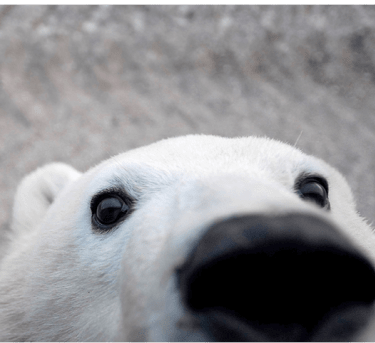Although polar bears spend much of their lives on the sea ice, most spend time on land — and a small number build their dens in areas at risk from wildfires.
While we generally — and correctly — identify polar bears with sea ice, throughout their range polar bears also often spend part of the year in other habitats. In Western and Southern Hudson Bay, for example, all bears must come ashore during the summer months as the bay’s ice melts completely each year.
Pregnant bears in Hudson Bay and other areas such as the Southern Beaufort Sea spend roughly three to four months over winter in maternity dens. In Hudson Bay, these have been carved into peat banks by generations of bears. Once inside, the females give birth, buffered by thick layers of snow that fall on the dens and shelter them from the outside world.
Fire can collapse den sites
As if it weren’t enough that polar bears are under pressure as a result of sea ice decline, there is concern about the potential impact on denning bears from the wildfires that have been raging with increasing severity and frequency in northern reaches of North America and Eurasia.
In 2007, a study led by Evan Richardson of Environment Canada examined approximately 150 den sites in Western Hudson Bay, of which 48 had been burned by wildfire. It found that burned den sites had significantly less tree, herb, and lichen cover than unburned den sites. Vegetation cover at burned den sites was limited and consisted primarily of herb and shrub cover as well as burned vegetation.
Concerningly, den sites that had been burned were much more susceptible to collapse, with 66 percent of all burned dens collapsing compared to only 23 percent of unburned dens. Much of this was a consequence of fire damaging permafrost, the layer of permanently-frozen soil that is a defining feature of polar regions and which provides stability to such peat dens. Additionally, at many burned sites, large blocks of peat had broken away and slumped down slopes.
Digging new dens wastes precious energy
The Arctic is a tough environment in which to live, and even species that are supremely adapted to it, such as polar bears, frequently live on the edge, with energy at a premium. That is why even a week less of sea ice coverage a year, meaning a week less of hunting food, can prove detrimental over the long term to the health of both individual polar bears and their populations. This is exacerbated with pregnant females, which have already spent the summer fasting when they enter their dens and go without food for several more months as they give birth.
Most maternity dens have been in existence for generations; claw marks in old trees in Wapusk National Park, where the bears of Western Hudson Bay den, show that bears have been scratching on the trunks for at least 200 years. Accordingly, bears generally do not have to expend energy carving new dens, and it is unknown how being confronted with the need to do so might affect them.
In 1999, fire destroyed 72 square miles of habitat, resulting in the greatest known loss of polar bear denning sites. Richardson’s paper noted that afterwards, some bears were initially observed returning and excavating shallow dens, but within five years none were seen denning in the area.
It also may not be a simple task for bears to simply move to a new location and create new dens. There is evidence that excavating a peat den in areas with a layer of permafrost near the surface takes multiple years, likely one reason why bears reuse the same dens for generations.
Climate change is increasing wildfire risk
The risk of fire damaging denning habitat is almost certainly elevated in a warming world. Climate change is causing an increase in wildfires instigated by lightning strikes, as well as a drying out of habitat that makes it more susceptible to burning; and the impact of fire damage itself exacerbates further habitat damage. As well as adding stability to the ground, permafrost may also provide a cooling microclimate in dens used for both temperature regulation and insect avoidance during summer months; as it melts, the ground absorbs greater solar radiation, creating further warmth, making dens potentially less suitable for bears and also leading to further instability.
Understanding the future impact of fire on dens
A team led by Stephen Petersen of Assiniboine Park Conservancy in Manitoba is creating a detailed map of habitat suitable for denning in the Hudson Bay region and overlaying it with areas of particular fire risk in an effort to determine areas of overlap and inform wildfire fighting efforts. The hope is that this will provide denning polar bears, already seeing their sea ice habitat disappear, with a degree of protection on land.

















